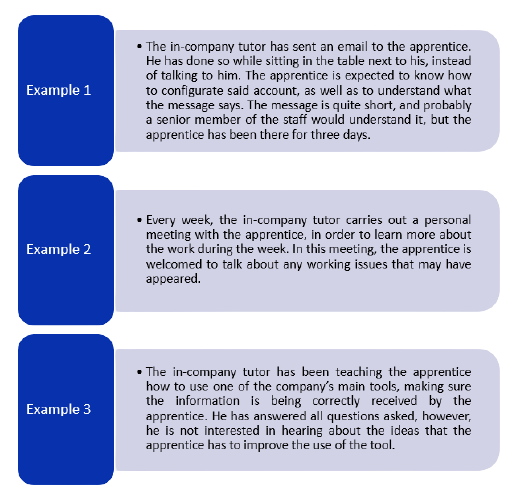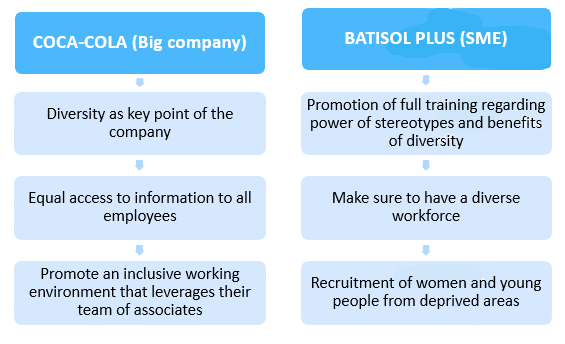Training Delivery
Ability to create a positive learning environment
In many ways, creating a positive learning environment is similar to creating a positive working environment. And the first thing that should always be taken into account is that communication is key. You should always base the learning environment in a positive communication environment, where your relationship with the apprentice is based on mutual respect and the communication between the different company levels is promoted. (Romero, 2016)
By establishing said positive communication, apprentices will feel more comfortable talking to you. Furthermore, an environment where the achievements are celebrated and highlighted can be very positive as well, because it will encourage the apprentice to try harder things. The combination of a good communication environment and an environment of shared success will make the apprentice more confident, and in turn, it will facilitate the apprentice feels comfortable and confident to express their opinion.

Now, why is it so important to make the apprentice comfortable? To begin with, they will feel encouraged to tell you when they have not understood something, or they have done something wrong. This is very important, as it can either save you a future bad work due to a lack of understanding, or it can give you extra time to solve any potential issue. (Fernández-Paniagua, 2018)
But also, if they feel comfortable telling you their opinion, they may end up giving you an alternative version of the situation that may be interesting for your company. Take, for example, the current hype of social media. Most users are millennials and Generation Z students, and they usually know which key moves are the best for each type of social media. If an apprentice working in your company feels comfortable giving their opinion, they may give you some ideas to improve your social media pages which, in turn, will make you get benefits for your company.
As it can be seen, a positive learning environment will only improve the learning path of the apprentice. And this, in turn, will also be positive for the company because it will improve the way in which the apprentice fits in the company. By hosting a positive environment for learning, the apprentice will feel comfortable in the company and he will be more willing to learn more and even stay longer there. If you are thinking of apprenticeship as a potential way of finding future employees, this is quite relevant for you!
Exercise
The following examples show some environment examples of certain companies. Take a look at them and decide among your group whether they are positive learning environments. Once you have finished, discuss your (potentially different) opinions, and how do you believe the environment could be improved.

Discussion topic
Apart from discussing the results of the previous exercise, another interesting point of discussion in this skill could be the following:
Do you believe creating a positive environment is as important as mentioned in the learning path of the apprentice?
Do you think it is important to take the same care of the learning environment as you would do with the working environment?
Ability to transfer the appropriate knowledge to the apprentices
The main aim in an apprenticeship relation is to transfer the apprentice knowledge from the company. Bearing this in mind, it is obviously necessary to make sure the transfer of knowledge is properly carried out.
However, knowledge transfer is not something you can just do without planning. First of all, it is required a level of previous preparation, this means, organising how the knowledge transfer is going to be performed. You cannot just bomb your apprentice with every knowledge you can think of on the first day, it is necessary to organise it a bit.
But secondly, as in-company tutor you should always bear in mind that not all knowledge is appropriate knowledge. Depending on the apprentice’s skills, you can decide which is the essential knowledge that should be transferred.
And thirdly, transferring knowledge requires certain ability, not just giving information to the apprentice without taking care of the form in which the transfer takes place. It is necessary to make sure the knowledge is effectively being transferred to the apprentice by using effective training techniques and methods.

In this sense, the previous chapter talking about designing a training programme may by useful for you. Furthermore, here you have some tips to make sure you are transferring essential knowledge (Núñez, 2017):
- Even if you are the in-company tutor of the apprentice, it can be interesting pairing the apprentice with other workers to let the person see how the work is done from different perspectives.
- It is also interesting to set a place where the apprentice can be provided with more “theoretical” knowledge. If you are transferring knowledge surrounded by sounds and activities that may be distracting, the apprentice can lose bits of information.
- Motivating the apprentice will always be a must. In order to effectively transfer knowledge, the apprentice needs to actually want to get said knowledge “inside him”.
In any case, the most important thing will always be remembering to match the knowledge that is going to be taught to the skills owned by the apprentice. As said in previous parts of this module, we need to provide knowledge and competences based on a training plan drafted based on the learner’s needs and gaps, which will always need to be linked to a specific professional/training profile and related competences, in order for the training to be expendable in the labour market.
Exercise: Is it true?
Know how to transfer the essential knowledge, by using his/her skills and find suitable techniques.
Take a look at the following statements and decide whether they are a good idea for knowledge transfer or not:
| Exercise: is it true? | TRUE | FALSE |
| When transferring knowledge, you should base it on the future needs of the company. | ||
| Transferring knowledge should always come from the assumption that the apprentice already has all theoretical skills necessary. | ||
| Motivating the apprentice is essential when transferring knowledge. | ||
| Since the in-company tutor is the person responsible for the apprentice, he should be the only one working with them. | ||
| In knowledge transfer, not all knowledge is necessary knowledge. |
Discussion topic
Apart from discussing the results of the previous exercise, another interesting point of discussion in this skill could be the following:
Up to which point do you believe all knowledge to be transferred is “appropriate knowledge”?
Ability to deal with special needs and diversity
Creating a diverse and inclusive environment is not just something related to apprentices. Every company should work to make sure their employees feel accepted and respected in their workplace, and this environment should be something already existing, in which apprentices will just dive in.
If you are working to create a diverse and inclusive environment in your company, here you have some tips that can be useful:
- Make sure your leaders and staff are educated: even if a company rules by diverse and integrative key points, workers in general, and especially in the case of apprentices, will be in direct contact not necessarily with the whole organisation, but with their teammates and direct bosses. In the case of apprentices, with the in-company tutor. And to make sure the environment is acceptant and respectful you should educate said people into the values you want to see in the company.
- Invite the staff (and in this case the apprentice) to share with the rest of the group the differences they may have. For example, having days in which workers from different countries explain their culture and the different traits of their country will make them feel like you are interested in them and the things that make them different.
- Listen to the apprentice: if you pay attention, you will learn a lot of information from what the apprentice says; if the person is happy, comfortable, worried, stressed… another good thing to do, also with employees is to create anonymous questionnaires where they can show how they feel about the environment of the company. (Gurchiek, 2018)
In this sense, it is also important to mention that, sometimes, apprentices may require specific treatments. You should always make sure that the training programme you are creating is directed to the needs of the apprentice, not only on an academic basis, but also with regards to their specific situation.
Exercise: Diverse environments
Here you can find some examples of companies that have worked to create a diverse environment. Taking a look at them, which points do you believe would be good for your company when working with your apprentice? (Elleedu, 2013)

Discussion topic
Apart from discussing the results of the previous exercise, another interesting point of discussion in this skill could be the following:
Do you believe promoting acceptance and respect towards the apprentice is as important as doing it towards the rest of the workforce?
Ability to select and apply appropriate training methods and techniques
The number of training methods and techniques available is almost unending. Depending on your preferences, you can find dozens of activities and exercises that will be useful for the apprentice, and which are usually aimed at concrete parts of the apprentice learning curve.
In the following chapter we have set up a list of training techniques you can benefit from when tutoring your apprentice.
The first thing you need to know is that there are two wide types of training methods and techniques: on-the-job and off-the-job. The first set correspond to those things you do while working in the company, while the second type refers to methods conducted outside the job office. Each of them has different activities, but at the end, both try to help the apprentice learn more and become a better professional. (Chand, n.d.)
Here you can see some examples of both types of techniques:
ON-THE-JOB ACTIVITIES

OFF-THE-JOB ACTIVITIES

Discussion topic
Apart from discussing the results of the previous exercise, another interesting point of discussion in this skill could be the following:
Do you believe all techniques and methods available for companies useful for an apprentice?

 Español
Español Italiano
Italiano Polski
Polski